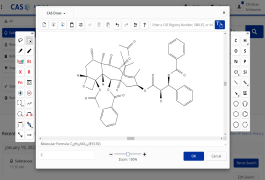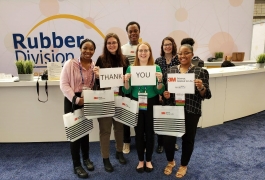Heroes of the Lab
Superheroes are always a trend of pop culture, especially with today’s highly advanced motion pictures captivating the imagination like never before. But for every superhero featured in a movie or comic book, there are hundreds more in labs across the country developing medicines, materials, and technologies that make the joys of modern life possible.
Currently, ACS doesn’t put out any comic books or movies. It does, however, honor amazing breakthroughs each year through the Heroes of Chemistry program, which recognizes scientists for their effort, ingenuity, creativity, and perseverance that lead to products that benefit all people. Here we take a closer look at the work of the 2017 honorees.
Better bendable light
Superman can bend steel, but bending light is a trickier proposition. Since the late 1970s, scientists used very thin fibers of silica glass, coated in plastics or other materials to transmit light. The index of refraction for glass and other materials governs how light reflects off the sides of the fibers, effectively transmitting light down the fiber like water through a pipe. This transmission can happen over long distances with little energy loss, making such optical fibers ideal for transmitting communication signals, such as on the Internet.
Optical fiber technology has been hampered by the inherent brittleness of the materials, but Dana Bookbinder, Ming-Jun Li, and Pushkar Tandon, at Corning, Inc., invented ClearCurve®. ClearCurve® features a conventional fiber encased in a flexible, nanostructured reflector. The reflector allows the fiber to be bent and twisted as needed, without breaking or losing signal.
This breakthrough has made it easier to take advantage of optical fibers wherever you need connectivity, such as data centers and apartment buildings.
Superpaints that help the planet
Sure, the Avengers save the planet in the comics, but a team at The Dow Chemical Company is helping to do it in real life. A greener paint has been developed by Linda Adamson, James Bardman, Kebedeh Beshah, Marie Bleuzen, James Bohling, Ward Brown, Stan Brownell, Michael Clark, Jr., Beth Cooper, Steven Edwards, David Fasano, Catherine Finegan, John Hook, Melinda Keefe, Al Maurice, Ozzie Moore Pressley, William Rohrbach, and Wei Zhang.
Paint products are needed everywhere. Whether it’s a new office building, an automobile, or a home rebuilt after a natural disaster, paint is used to beautify and protect. But beauty comes at a cost. The most common pigment is titanium dioxide. It is non-toxic and makes the paints brighter and more opaque, however the process for manufacturing it is energy-intensive and has undesirable byproducts.
The Dow team developed AVANSETM acrylic resins and EVOQUETM Pre-Composite. These materials form a shell around the titanium dioxide particles that separates them and forces the particles into a more ordered, well-distributed arrangement as the paint dries. The result is paint that uses less titanium dioxide, has better “hiding” performance, and also builds in better barrier properties, making paints more durable against stains, water, and UV rays.
Additionally, the improved performance means more can be done with less paint, which is easier on the planet, as well as the wallet. So, the Dow team’s superpower is creating super-paints!
Protecting our food without destroying the ecosystem
Even Groot could fall prey to plant diseases, such as light blight, downy mildew, and crown rot. These diseases, caused by oomycete pathogens, wipe out billions of dollars’ worth of potato, grape, and vegetable crops annually.
At Dupont, John Andreassi, Mary Ann Hanagan, Lisa Hoffman, Robert Pasteris, and James Sweigard sifted through over 100,000 compounds to develop ZorvecTM (oxathiapiprolin), a fungicide that attacks oomycete pathogens without damaging anything else.
Zorvec attacks the oxysterol-binding protein (lipid-binding proteins that are conserved from yeast to humans) in oomycetes, impacting the pathogen’s life cycle at multiple points. It sticks tightly to crops, so it lasts a long time. Even better, it doesn’t attack the crops, and it has low toxicity among bees, birds, and mammals (including humans).
Zorvec disease control is currently registered for sale in 14 countries around the world on 10 crops, including potatoes, grapes, tomatoes, and peppers. Thanks to Dupont’s “Guardians of the Gardens,” we have powerful new tools in protecting the crops that feed the world.
New tool for battling cancer
Batman has a seemingly unending supply of abilities, skills, and technologies to fight supervillains, but not a single one to battle cancer. Remy Angelaud, Georgette Castanedo, Janet Gunzner-Toste, Michael Koehler, James Marsters, Kirk Robarge, Scott Savage, Dan Sutherlin, Vickie Tsui, and Shumei Wang at Genentech devised their own cancer-fighting tools.
Basal cell carcinoma is the most common form of skin cancer in Europe, Australia, and the United States. If it metastasizes (spreads) to the ears, nose, eyes, bone, or other tissues, treatments can be disfiguring or even outright impossible. About 5,000 adults are affected annually by advanced basal cell carcinoma.
The Genentech team developed Erivedge® (vismodegib), which is a “hedgehog” pathway inhibitor. In fetal development, the hedgehog pathway is a cell-signaling pathway that guides proper cell differentiation. The pathway is supposed to shut down after the fetus is developed, but in basal cell carcinoma, the pathway is reactivated and out of control, causing tumors.
Vismodegib binds to a specific protein in the hedgehog pathway, effectively shutting it down. Tumors shrink or even disappear. In 2016, this new tool gave hope to over 3,500 people who were previously facing a death sentence.
Cure for Hepatitis C: Part I
If you need help with the weather, call deputy leader of the X-Men, Storm. If you need a cure for hepatitis C, you now have two real-life groups of heroes at Bristol-Myers Squibb and Merck. A team of researchers at Bristol-Myers Squibb devised a cure for hepatitis C. Hepatitis C is a contagious liver disease that kills almost 400,000 people annually. About 71 million people worldwide have chronic hepatitis C.
Until recently, the only treatments available attempted to bolster the patient’s immune system to fend off the disease. Makonen Belema, Min Gao, Andrew Good, Lawrence Hamann, Fiona McPhee, Nicholas Meanwell, Van Nguyen, Paul Scola, Lawrence Snyder, Li-Qiang Sun, and Alan Xiangdong Wang at Bristol-Myers Squibb changed that.
The team discovered that the combination of daclatasvir and asunaprevir attacked the virus itself, with over 90% cure rates. Daclatasvir (marketed under the brand name DaklinzaTM) is the first hepatitis C virus inhibitor recognized by the U.S. Food and Drug Administration (FDA); specifically, it disrupts the NS5A protein, a key protein in the virus’s transcription and translation process. Asunaprevir is a tripeptide-based acylsulfonamide (marketed as Sunvepra) that inhibits the virus enzyme, serine protease NS3.
The combination of daclatasvir and asunaprevir has been used to treat more than 228,000 patients since its approval in 2014.
Hep C: Part II
It’s not exactly a sequel, but a team at Merck developed their own treatment for hepatitis C. Zepatier® is a once-a-day pill containing grazoprevir, a protease inhibitor, and elbasvir, a replication complex inhibitor. The drug achieves cure rates of between 94 and 100 percent in some patients with chronic hepatitis C infection.
Zepatier® was developed by Craig Coburn, Steven Harper, Daria Hazuda, M. Katharine Holloway, Bin Hu, Nigel Liverton, John McCauley, Craig McKelvey, Mark McLaughlin, Peter Meinke, Michael Rudd, Vincenzo Summa, Feng Xu, Bin Zhong, and Ping Zhuang. This superteam of medicinal, analytical, process, formulation chemists and biochemists saw their treatment achieve breakthrough status and fast-track review from the FDA, which joined 20 other countries in approving the drug.
Zepatier® works by targeting the NS5A and NS3/4A proteins in the hepatitis C virus. It has been approved for use in a wide range of patients, including those patients with renal impairment, low-level liver cirrhosis, or HIV infections.
inChemistry congratulates the 2017 Heroes of Chemistry, who have made our world greener, healthier, and more technologically advanced.




